Parishes of Jamaica, Pre-1655 to Present
How the Parishes Transformed
Under Spanish Rule
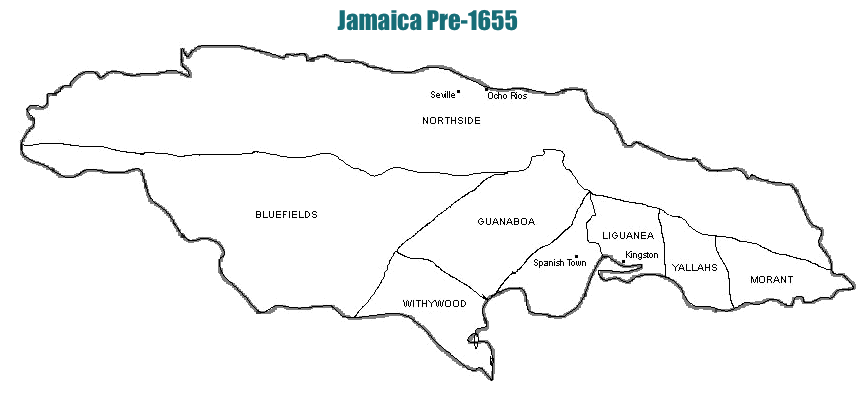
Under the rule of the Spaniards, the island of Jamaica looked similar to the map above. Yallahs and Morant were names of large Spanish ranches. Guanaboa and Liguanea were taino names. Liguanea is still used today to refer to lower St. Andrew. The capital of the island was Seville from 1510-1535. Spanish Town became the capital from 1535 to 1872, except for 1755 when Kingston became the capital for a year. Kingston became the capital in 1872 and still is today.
Under English Rule (1655 onwards)
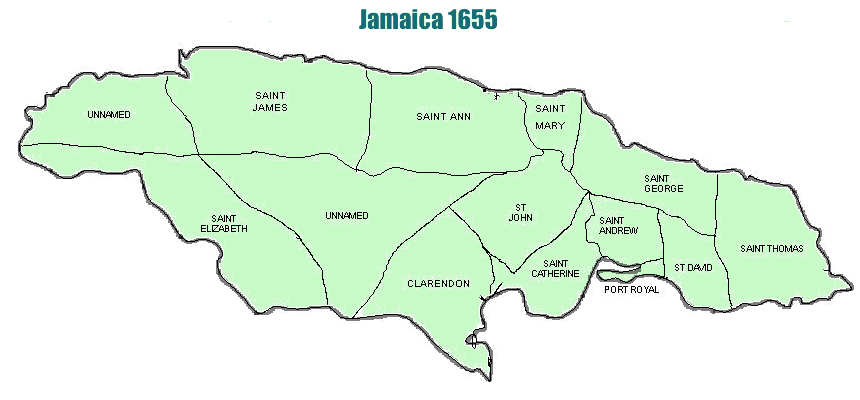
The English applied their own system of administration once they took control in 1655. The island was divided into parishes with most of names given the designation of "St. (Saint)". Originally seven parishes were named after governors, important persons or places in Britain; Clarendon, St. John, St. Andrew, St. Catherine, Port Royal, St. David and St. Thomas. These combined with the others, some of which were unnamed, made up 14 parishes between 1655 and 1675. During this period Port Royal was a separate parish.
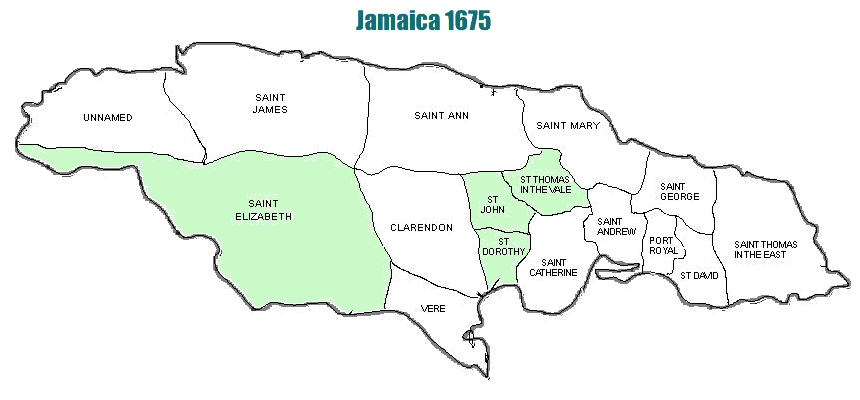
Between 1675 and 1692, there were 16 parishes. Three parishes that exists today - Manchester, Westmoreland and St. Elizabeth - were all one parish named St Elizabeth. There were also some additional parishes during this period: St. Thomas in the Vale, St. John, St. Dorothy. St Mary was enlarged and St. George made smaller. The area known today as Hanover and a part of Westmoreland combined to make an unnamed parish.
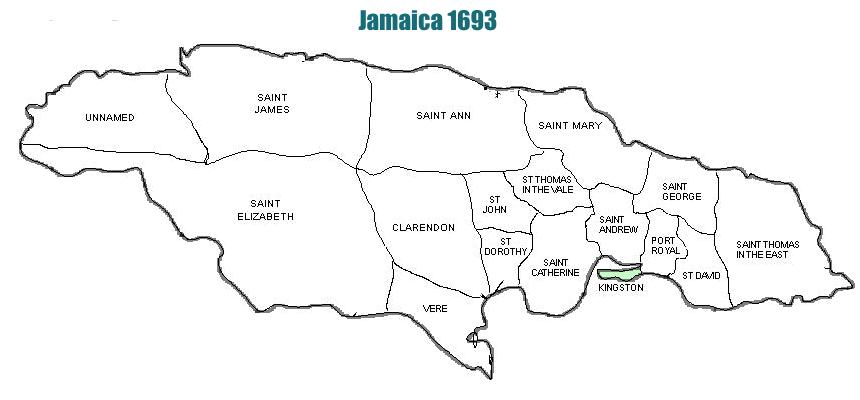
During the period of 1693-1702, Kingston separated from St. Andrew, creating a 17th parish consisting of what is known today as the Palisadoes peninsular where the Norman Manley airport is located.
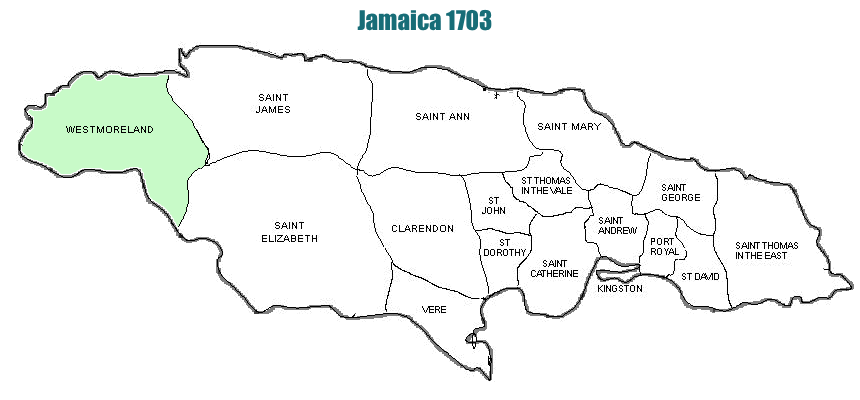
Between 1703-1723, the number of parishes remained at 17, but a portion of what was then St. Elizabeth was carved off and annexed to the "Unnamed" parish which was named Westmoreland.
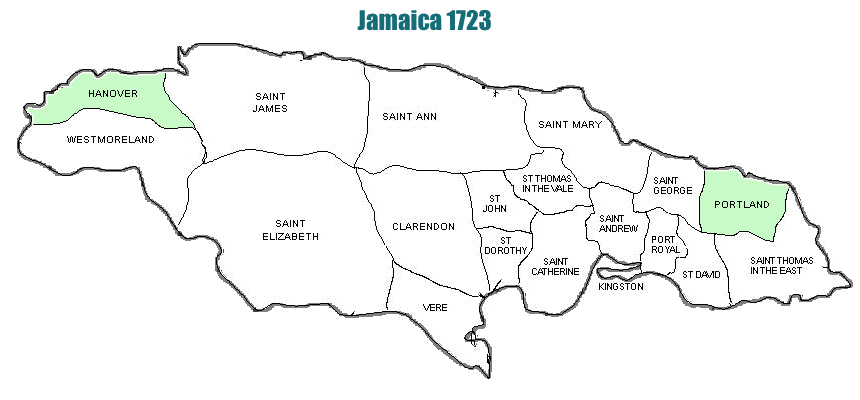
In 1722, the Duke of Portland became Governor and an 18th parish was named after him. Portland was created in 1723 by carving off and combining parts St. George and St. Thomas. The parish of Hanover was also established on November 12, 1723 from a section of Westmoreland, making it a total of 19 parishes.
In 1758 the island's parishes were divided into three counties - Cornwall, Middlesex and Surrey.
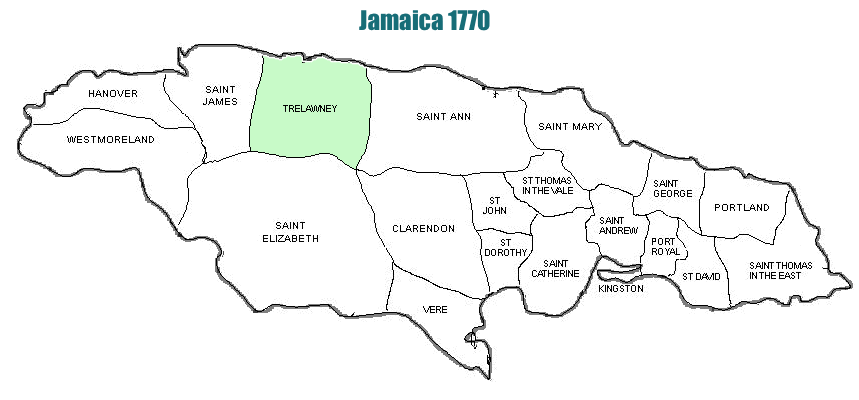
The 20th parish of Trelawny was created in 1770, when the wealthy planters in St James and St Ann, who deemed they were too far from administrative centers, succeeded in having sections of both parishes combine to form the new parish of Trelawny. Trelawny was named after Sir William Trelawny then Governor of Jamaica, whose prominent family originated from the manor of Trelawny in the parish of Pelynt in Cornwall, England. The first capital was Martha Brae, located 3 kilometres (1.9 mi) inland from Rock Bay.
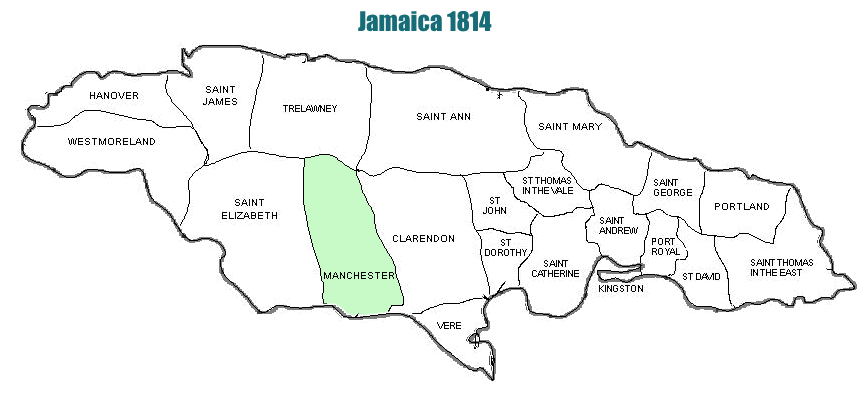
The Duke of Manchester governed Jamaica between 1808 and 1811. The parish of Manchester was created in his name in 1814, bringing the total to 21.
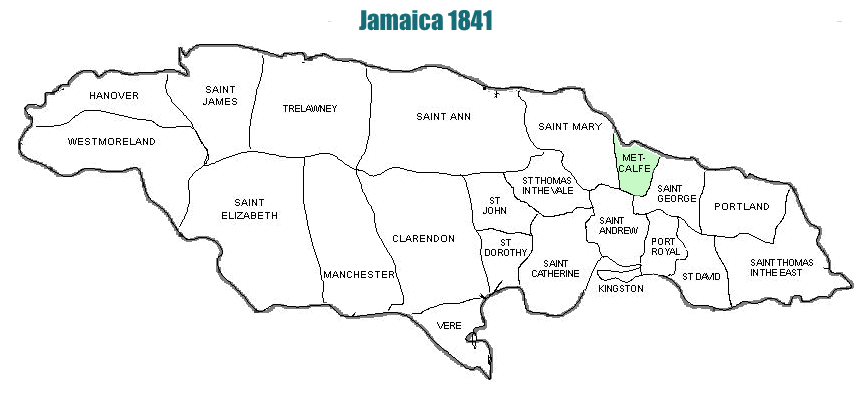
In 1839, Sir Charles Metcalfe became governor of Jamaica. Just before he left office in 1842, Metcalfe parish was created from St. George and St Mary, resulting in 22 parishes.
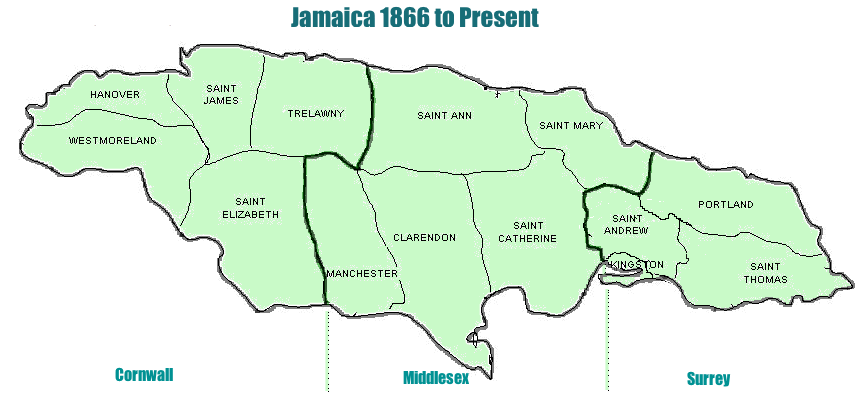
In 1866 eight parishes were eliminated through consolidation, leaving the fourteen parishes that exist today. Vere was merged into Clarendon, St. David merged into St. Thomas , St. Dorothy, St. John and St. Thomas-in-the-Vale merged into St Catherine and St. George merged into Portland. Most of Port Royal was absorbed by St. Andrew and a smaller portion became part of Kingston parish. Metcalfe was merged into St. Mary.
information as seen at https://www.fiwiroots.com/parishes-transformation.html
Our Parishes
How did they come about and how did they get their names - Jamaica's parishes explained.
IN 1664, the Spanish relinquished control of Jamaica to the British and Sir Thomas Modyford divided this fair isle into 7 administrative units known as parishes. These were located mainly in the mid to south- eastern end of the island: Clarendon, St. John's, St. Andrew's, St. Katherine's, Port Royal, St. David's and St. Thomas in the East. Within 25 years, by 1683 the number of parishes had doubled totalling 15 parishes as St. Dorothys, St. Thomas in the Vale, Vere, St. George's, St. Marie's and St. Ann's and St. James and St. Elizabeth's were added. In 1692 earthquake survivors fled across the harbour and Kingston was formed a year later.
By the mid-eighteenth century parishes covered the entire island.
In 1758 the island's 3 counties Surrey, Middlesex and Cornwall were created to facilitate more convenient holdings of courts of Justice. Surrey has 4 parishes Kingston, the smallest parish, St. Andrew, St. Thomas and Portland. Middlesex has 5 St. Catherine, St. Mary, Clarendon, St. Ann and Manchester. Cornwall also has 5 St. Elizabeth, Trelawny, St. James, Hanover, the second smallest parish in the island, and Westmoreland. In the mid-nineteenth century, Jamaica recorded its largest number of parishes 22.
In 1867 some parishes were melded into others and the island was left with 14 the number of parishes we have today. Each parish has a capital town and serves as a unit of local government. Kingston, which existed as a settlement of houses in the mid-1600s prior to even its formation as a town, became the capital of Jamaica in 1872. It acquired this position due to its function as a major centre for commerce and communication.
The parish of St. Andrew, formed in 1867, was originally called Liguanea after the Liguanea Plain in which it lies. Since most of the other 13 parishes were named after governors of Jamaica, their wives, or English kings, it is possible that St. Andrew derived its name similarly. St. Thomas, for example, may have been named after Thomas, Lord Windsor, Governor of Jamaica in 1662. Portland was named after the Duke of Portland, Governor in 1723, the year of the parish's formation. Kingston was once called Beeston after Sir William Beeston who served as Lt.-Governor of the island from 1693-1700. It is not known how the parish received the name Kingston although a letter from Port Royal dated July 3, 1693 referred to it being known by some as "Kingston" and others as "killcown". Kingston was made a parish in 1713.
In 1758 the island's 3 counties Surrey, Middlesex and Cornwall were created to facilitate more convenient holdings of courts of Justice. Surrey has 4 parishes Kingston, the smallest parish, St. Andrew, St. Thomas and Portland. Middlesex has 5 St. Catherine, St. Mary, Clarendon, St. Ann and Manchester. Cornwall also has 5 St. Elizabeth, Trelawny, St. James, Hanover, the second smallest parish in the island, and Westmoreland. In the mid-nineteenth century, Jamaica recorded its largest number of parishes 22.
In 1867 some parishes were melded into others and the island was left with 14 the number of parishes we have today. Each parish has a capital town and serves as a unit of local government. Kingston, which existed as a settlement of houses in the mid-1600s prior to even its formation as a town, became the capital of Jamaica in 1872. It acquired this position due to its function as a major centre for commerce and communication.
THE PARISHES OF SURREY
The parish of St. Andrew, formed in 1867, was originally called Liguanea after the Liguanea Plain in which it lies. Since most of the other 13 parishes were named after governors of Jamaica, their wives, or English kings, it is possible that St. Andrew derived its name similarly. St. Thomas, for example, may have been named after Thomas, Lord Windsor, Governor of Jamaica in 1662. Portland was named after the Duke of Portland, Governor in 1723, the year of the parish's formation. Kingston was once called Beeston after Sir William Beeston who served as Lt.-Governor of the island from 1693-1700. It is not known how the parish received the name Kingston although a letter from Port Royal dated July 3, 1693 referred to it being known by some as "Kingston" and others as "killcown". Kingston was made a parish in 1713.
THE PARISHES OF MIDDLESEX
St. Catherine, formed in 1867, was named after Charles II's Queen, Katherine, and it was once spelled as such. Charles II was king when the parish was formed. St. Mary, may have been named after the Spanish port Santa Maria, although Modyford's daughter was called Mary and when St. Mary was first formed, it was next to the parish of St. George which was named after George Nedham, Mary's husband. Clarendon was named after Cromwell, the Lord Chancellor and St. Ann was named after Ann Hyde, wife of James II. In 1814 Manchester was formed from the parishes of Clarendon, Vere and St. Elizabeth. It was named after the Duke of Manchester who was governor of Jamaica when it was formed.
THE PARISHES OF CORNWALL
St. Elizabeth was named in honour of Elizabeth, wife of Sir Thomas Modyford, who was Governor when it was formed in the seventeenth century. Trelawny, formed in 1770 was named for former governor Sir William Trelawny who died in Jamaica in 1772. St. James was named for the Duke of York who became James II. Hanover, formed in 1725-26 out of parts of Westmoreland and St. James, it was named after the then reigning family in England it was originally to be called St. Sophia in honour of the mother of George I but this idea was overridden. Formed in 1703, Westmoreland's name may simply come from the fact that it is the westernmost parish in the island. Each parish has unique places of interest and characteristics. St. Ann, for example, is known as the Garden Parish for its extreme beauty. The population of our 14 parishes is approximately 2.6 million people, the majority of which reside in the parishes of Kingston and St. Andrew.
from : old.jamaica-gleaner.com/pages/history/story0013.html
